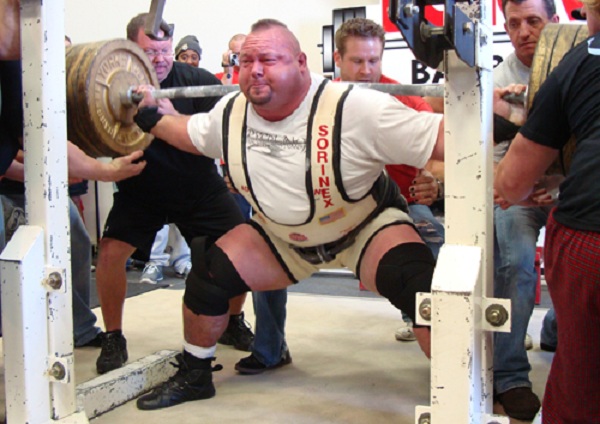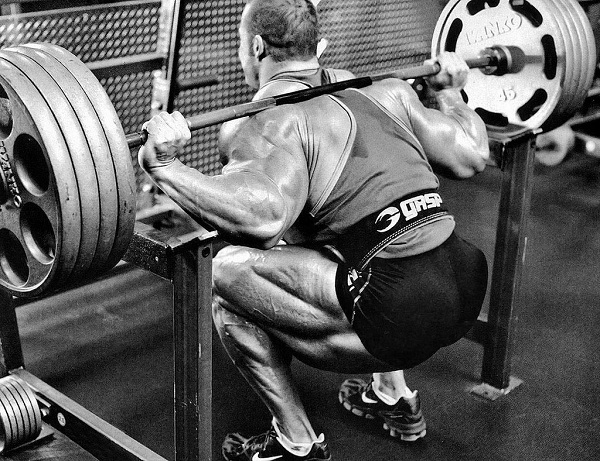
The squat is one of the key exercises that we all do in the gym but for many people it leads to knee pain, so here is how to Squat Pain Free.
When pain hits, most people just stop doing the exercise. This is the wrong approach. Let me show you a few tweaks that you can make in order to make the squat pain free.
7 Ways to Squat Pain Free…
#1 Move Your Feet Out
If you squat and your stance is narrow, there is more stress on the knees compared to a wider stance.
Look at moving your feet greater than hip width apart. This will shift more of the weight onto your hips and decrease the stress on your knees.
#2 Toe Out a Touch
When you are setting up in the squat position, move your feet and toes from straight ahead to a touch out.
This brings in the calves into the squat, in order to help you press harder into the floor and get the help from the calves and take some of the load off the knees when performing the squat.
#3 Increase Your Squat Depth
When you perform a partial squat or a parallel squat (thighs parallel to the floor), it is all knees that do the work.
If you increase the depth that you do the squat so your hips move past your knees in depth, this will bring in the gluteus and the gluteus will help you get out of the bottom position of the squat. This leads to less stress on the knee and a good challenge to the hips.
If you cannot do this without perfect technique or do not have the knee strength to do it, head over to the smith machine or leg press. These machines put less stress on the knees and then you can move back into the squat. You can use them to improve the strength that you have in the knee at greater ranges of motion and also these machines.
#4 Press the Knees Out
When performing the squat, work on pressing the knees out. This will help make sure that the knees do not collapse inwards, which will lead to more stress on the knee. Keep the knees out will bring more of the hips into the exercise which will help take stress of the knees and make the squat more stable to perform.

#5 Try a Low Bar Squat
The traditional back squat involves the bar on the upper traps. This is called a high bar position squat. You can move the bar lower down your back so it is in on your posterior deltoid area. The changes the exercise to a low bar squat, which will move your trunk more forward, and you will bend more at the hips.
This will shift the load from the knees to the hips and lower back. Just remember the low bar position puts more stress on the shoulders and elbows. Plus you need good flexibility in the shoulders in order to do the exercise right.
#6 Keep Your Shin Vertical
When performing the squat, try to keep to the shin as vertical as you can. This means, try to keep your shin and foot at a 90-degree angle to the floor.
This will put less stress on the internal structures of your knees, like the meniscus and cartilage.
Your knees might pass a little and that is okay. Do the best you can to minimize how much they pass.
#7 Keep Your Knees out of Unnecessary Stress
This has nothing to do with squatting in the gym but it will affect your knee pain. Look at what you are doing day-to-day to see what is putting unnecessary stress on the knees. Being on positions where the knee is bent, pushed back and kneeled on for a long period of time all put unnecessary stress on the knee.
Do what you can to eliminate or minimize this and your knees with thank you.
Conclusion
You can squat pain-free. Next time you squat, try to move your feet wider apart and toe out a touch. Work on increasing the depth of your squat so your hips pass your knees and your shins are as vertical as you can. Also try to change the bar position from a high bar position to a low bar position. Lastly, look at what you do on a day to ay basis and keep your knees out of unnecessary stressful position.
That is it. Give the 7 tips above a go and get back to pain-free squatting.
[author_bio name=”yes” avatar=”yes”]
Latest posts by Terry M (see all)
- Garage Gyms - Aug 1, 2018
- Kettlebells – Why They Should Be Added To Your Routine. - Jul 24, 2018
- Weight Belts: What Are They Really For? - May 31, 2018











